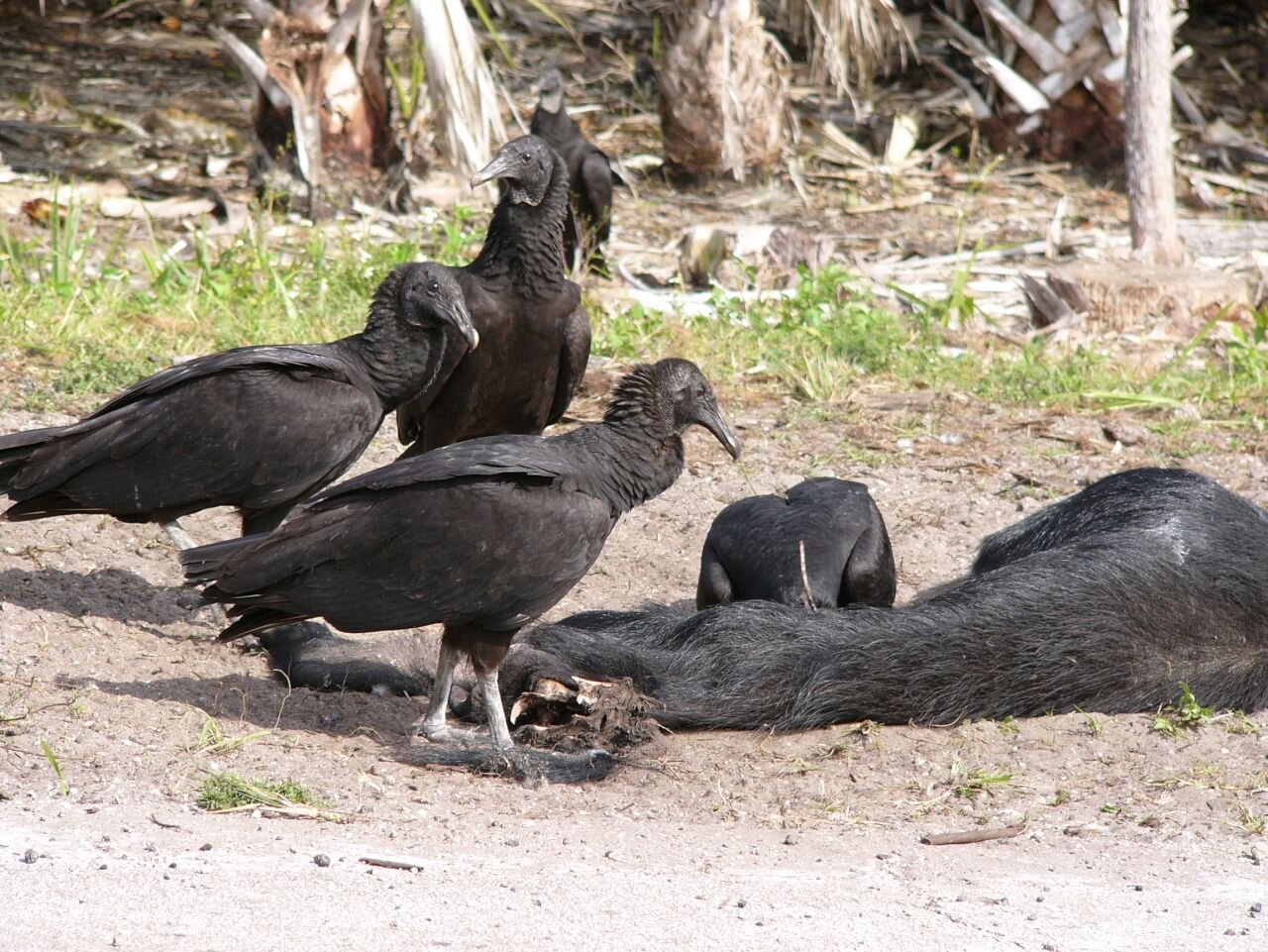A Turkey Vulture and a Black Vulture ignore pecking order and share
Can you imagine a world where all the animals, birds, fish and the like, dying in fields, forests, lakeshores, beaches, on our highways and by-ways, and anywhere and everywhere else they may find to finally end their life’s adventure, were to remain, rotting, putrid and stinking, in their final unburied resting place until temperature, humidity, and natural decomposition succeeded in disposing of them? We should thank heaven every day for all those scavengers that do that job for us. Yes, thank heaven for those homely vultures we see soaring high over-head all day long, constantly searching and giving us reason to “Look alive!”
On a recent trip to Joe Overstreet Road, a premier Florida birding destination through farm country to the shores of Lake Kissimmee, we observed a dead cow in an adjoining field already in the process of disposal by a good number of vultures. This particular sighting was of unusual interest because a Turkey Vulture (red head) and a Black Vulture (black head) were standing side by side on top of the carcass. Bird scavengers have a definite pecking order: 10 Turkey Vultures will step back and patiently wait out one lone Black Vulture; 10 Turkey Vultures and 10 Black Vultures will step back and wait out one lone and smaller Crested Caracara (photo 2); and if a Bald Eagle or two show up, all other scavengers will back off until the Eagles are finished, although the Eagle may occasionally have to assert its dominance to a pushy Black Vulture. (photo 3).
One does not normally think of a fish-eating Eagle as a scavenger, but we have often seen eagles on animal remains, as well as harassing Ospreys to steal their hard-won fish meals. These were the reasons Benjamin Franklin gave in denigrating the scavenging thieving Bald Eagle as America’s national symbol when he favored the “much more respectable” Wild Turkey.
We have seen Black Vultures just preparing to start work on a fresh road-killed Wild Hog (photo 4) realizing that without beaks for tearing flesh like hawks and eagles, they would have to find a way to break through the hide of the animal for we could not see any break in its skin from the vehicle impact. I then remembered a Florida farmer friend informing me that he had watched Black Vultures actually attack a dying calf to hasten its demise so that they could feast.
Turkey Vultures have the ability to strip a carcass clean leaving the bare bones for other predators, such as coyotes and foxes that can break the bones to get to the marrow. (photo 5) Both species of vultures have featherless heads because of their propensity to dig into bloody carcasses. Thus, they don’t have to worry about getting a lot of sticky gooey blood on their head feathers.
Turkey Vultures have much more highly developed olfactory senses and are better able to find well-hidden carrion than their Black cousins. Hence, Black Vultures will often follow Turkey Vultures hoping they will lead them to their next meal. In the air the two species may appear quite similar, but when seen in close proximity there are significant differences in their flight profiles as seen in photo 6.
Finally, both species of Vultures are able to eat rotting carrion because they have stomach bacteria that enable them to eat such fare that would make virtually all other creatures, animal or avian, quite sick. A friend who just returned from the west coast of Florida reported watching thousands of Vultures feasting on rotting fish killed by the red tide and washed up on pristine Gulf coast beaches while simply smelling the toxic red tide made many humans ill.
The much less common Crested Caracara is a sought after attractive prized bird find for our birding friends from “up North.” And while quite a beautiful bird, like the Bald Eagle, it is still just a scavenger. (photo 7) In fact, when seen carrying a dead fish carcass with no apparent nutritional value (photo 8) one wonders about the incongruity of such a beautiful bird in such a degrading circumstance.
Out west and farther north the Common Raven (photo 9) is often found on carrion along with the vultures and occasional eagles. Ravens are not found in Florida, but in recent years they have moved south into the Mid-Atlantic States and, who knows, they may eventually find their way to Florida as many other “Snow-birds” have.
While we humans have developed sometimes elaborate methods for disposing of our deceased comrades, from pyramids to crypts to graveyards with massive headstones to crematoriums, the poor animal suffering a losing battle with a speeding semi remains in its final resting place until nature’s clean-up crew comes to take care of it.
Caricatures of undertakers over the years have made them appear almost vulture-like. Perhaps that is not accidental, but it certainly gives vultures a bad image considering what tremendous benefits vultures provide for us. Then again, I guess it is appropriate since vultures are almost exclusively associated with death. While never a happy subject, final remains do indeed need to be disposed.
I don’t for the life of me know why I chose this topic just before Christmas, one of the happiest times of the year. Next year perhaps I will do a column on nests and baby birds. Oh yeah!!
For more on Ben Franklin’s thoughts on America’s Great Seal: https://greatseal.com/symbols/turkey.html. Why vultures can eat rotting flesh: https://www.livescience.com/48899-vultures-bacteria-microbiome.html








